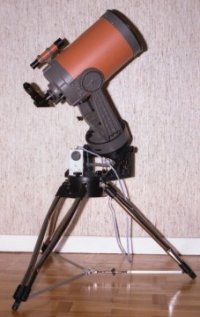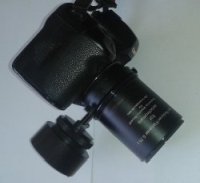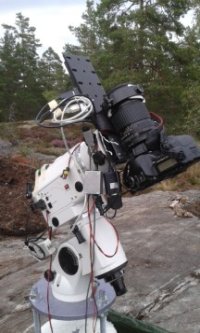My Astronomy equipment
Astronomy, how it started
My interest about astronomy started 1964 when my father built a 2" f/12 refractor to me, I still have the lens in my desk.
I observed the moon, the planets and Orion nebula with it. I wish that I had some photos of this first telescope.
After that I had a lot of different equipment, not very advanced until recently.
The 5.2" APO refractor is of high quality and exiting and that's the one I'm working with now.
|
Content:
- Telescopes
- Photography lenses
- Cameras
- Mounts
- Windows software
- Android apps
- Linux software
|
|
1: Telescopes:
- 2" f/12 refractor
My first telescope, my father built from a lens he bought, mid 1960s.
- 3.5" f/12 refractor
Built from military equipment (from the beginning it was a signal lamp),
this was a big telescope at that time, early 1970s.
- 8" f/10 Celestron C8 Schmidt-Cassegrain
Even bigger telescope, a dream come through.
When I had this telescope I lived at fourth floor and no elevator! 1980s.
- 4" f/10 refractor Chinese built
Had this telescope for a short time, much better than my older telescopes,
it was light and I could bring it with me, 1990s.
- 4" f/10 Rubinar Maksutov Russian built
Very compact and sharp telescope (or photography lens),
but the complicated optical construction gave ghost reflections in some situations, 1990s.
I took this sequence of the solar eclipse in 1999 with it:
Solar eclipse 1999
- 8" f/5 Celestron CN8 Newton / Cassegrain
Had this telescope only for a short time, but fast and not too heavy, 1990s.
- 4.75" f/8.3 SkyWatcher refractor
After many years without a telescope I bought this refractor telescope.
Used it visually and I felt it was better than my earlier telescopes.
With my QHY5 camera I saw Uranus. 2000s.
- 10" f/4.7 SkyWatcher Newton
My biggest telescope yet.
Had replaced the original focuser with a high quality focuser.
Like this telescope a lot but had no space for it, 2010s.
- 5.2" f/7 APO TS130 refractor *
This is what I have today, my first really good telescope to use for astrophotographing,
cost a lot of money but it deliver sharp stars and no color aberration.
I don't use it for visual observing.
Lot of things to work out before perfect.
Read here how I built an anti dew heater:
Anti Dew heater project
- Binocular, 25x100
My latest, not a big fan of visual observing, but now I will give it a try, 2017s.
Read here about my big binocular project:
Big binocular project
* still in use
|

|
|
2: Photography lenses:
- f/2.8 16 mm fish eye, 35 mm format, Zenitar with Pentax M42 mount
Fine 180 degree angle lens, very robust, it's Russian built !, 2009.
- f/1.8 50 mm normal, 35 mm format Canon EOS *
I don't get sharp stars at the edges at full frame with aperture set to f/4, 2008.
- f/4.0 50 mm, Carl Zeiss, Pentacon SIX
- f/2.8 80 mm, Carl Zeiss, Pentacon SIX
- f/2.8 180 mm, Carl Zeiss, Pentacon SIX
- f/3.5 250 mm, Jupiter (Russian), Pentacon SIX
My plane was to use these famous medium format lenses for astrophotography, but they where too old for this.
More to collect for it's beauty, 2006.
Look here:
Pentacon SIX and Pentax M42 lenses
- f/6.3 400 mm, 35 mm format, Yashica with Pentax M42 mount *
Use it as a guide telescope.
- f/8.0 500 mm mirror, 35mm format, Soligor with Pentax M42 mount
- f/8.0 500 mm mirror, 35mm format, Centon with Pentax M42 mount
Very compact but too low contrast for astrophotographing, 2008.
- f/4.5 500 mm 35 mm format, Pentax with 6x7 and M42 screw mount
This lens I used a lot to full frame work, worked well, but of course some chromatic problem, it's not an APO construction, 2013.
- f/5.6 500 mm 6x6 cm, Meyer Optik Görlitz Orestegor, with Pentax M42 mount
This lens was something I looked for many years, now when I own it I don't have any use of it, 2018.
- f/7 910 mm 3" focuser, TS130 APO triple lens refractor *
- 0.75x Riccardi field flattener and reducer to above telescope, system gives f/5.2 682 mm *
This is what I use today as an Astrograph.
Lot of things to work out before perfect.
One of them are are to get a corrected field to a full frame camera:
Field flattener project
and get the focuser precision better:
Motor focus project
These problem are solved today after a lot of work and with help of the 3D-printer.
- f/2.8 165 mm Pentax 6x7
Very big field, almost no vignetting and long back focus because it's a medium format lens.
I use it with an adapter to Canon EOS DSLR, 2014.
- f/2.8 150mm 35 mm format, Sigma APO for Canon EOS *
Sharp to the edges at f/4, see my test of vignetting and photo of Andromeda galaxy and its surroundings:
Test vignetting and photo of Andromeda galaxy, 2015
- f/2.8 70-210 mm 35 mm format, Sigma APO for Canon EOS
A lens that I haven't tested yet, older construction and doesn't communicate correctly with digital DSLR cameras, but the optics seems to be of very high quality, 2014.
- f/4 20-35 mm 35 mm format, Tokina for Canon EOS *
The lens I use most when on travel, the optics are of very high quality. I sold my fisheye lens, maybe I can use this one instead, 2015.
- f/2.8 24-70 mm 35 mm format, Tamron for Canon EOS *
My latest lens, the optic is of very high quality and it has image stabilization, 2019.
- f/4.0 300 mm 35 mm format, Canon L for Canon EOS
Needed something to catch big objects with, 2017.
Test photo of Andromeda Galaxy.
- f/4.0 300 mm medium format, Pentax 645 ED *
Bought to replace my Canon 300mm lens, lower vignetting at f/4, 2021.
My Pentax 645 300mm project.
* still in use
|

|
|
3: Cameras:
- Konica T3, SLR
The camera for 35 mm film, modified to let the matte screen be viewed through an eyepiece direct (pentax prism removed), 1988.
- SpectraSource Instruments HPC-1, 1024x1024 array
My first digital photos in the 1990s was taken by this camera, from Stockholm University.
One of the photos was of the comet Hyakutake:
Hyakutake 1996
- Philips Toucam pro II, web camera
Modified for raw image, only used as a guide camera with my EQ6 mount, 1999.
- Canon 350D, 8 Mpixel, DSLR
My first DSLR camera, 2006.
- Canon 5D, 12 Mpixel, DSLR
My first full frame digital camera. Worked very good for astrophotography in that time, but the communication over USB was complicated, 2013.
- QHY5m, 1.8 Mpixel, CMOS *
This one only for auto guiding, it's monochrome and much better than the color web camera I used earlier for this purpose, 2014.
- Canon 6D, 20 Mpixel, DSLR *
My latest camera, lower static pattern than my Canon 5D, 2016.
- ASI 120 mm, guide camera *
This one will be used on my APO refractor later, 2021.
* still in use
|
 |
|
4: Mounts:
- Homebuilt mount with friction clutches
My father built this mount to me, 1960s.
- Homebuilt, equatorial mount
This one I built by myself, roller bearings, parts from old military equipment, 1970s.
- Celestron C8 equatorial fork mount
Friction bearings in Dec & RA, 230 volt motor in RA, I built a DC motor to it later, 1980s.
- EQ3, equatorial mount
Friction bearings in Dec, worm gear in both axis, 2000s.
- EQ4, equatorial mount
Friction bearings in Dec, worm gear in both axis, motor in RA, modified to be more stable, 2006.
Look under project pages how to:
EQ4 project
- EQ5, equatorial mount
Very stable, friction bearings in Dec, worm gear in both axis, 2010s.
- EQ6, equatorial mount, GOTO Synscan *
The mount I use today, good but I want an EQ8, 2010s.
Read here how I built a pier for it:
EQ6, build a pier project
Read here how I built the computer control and power unit:
EQ6, battery and computer project
- Observatory *
Recently I have begun to build an observatory, 2010s.
Read here about my project:
Observatory project
- Star Adventurer
This is my favorite for the moment, easy to bring with you to the dark places, motor in RA, 2010s.
See more details under project page:
Star adventure project
- EQ2 mount
I'm not sure to what use I will have of this mount, 2017s.
See more details under project page:
EQ2 project
- HEQ5 mount *
My new portable mount, 2021.
Modified to low rider model: HEQ5 mount.
* still in use
|

|
|
5: Windows software:
I run these software on Windows XP, Vista, Win 8, Win 10.
All these software are free to download,
some can be paid to get extra features.
Installed in astro server (Windows):
- UltraVNC (sever) *:http://www.uvnc.com/
Remote controller of astro server.
- ASCOM:http://ascom-standards.org/
Connecting my software together.
- EQMOD:http://eq-mod.source forge.net/
Direct controlling my EQ6 mount without the hand terminal connected. See also Yahoo forum.
- CdC (Skychart) *:https://source forge.net/ projects/ skychart/
Starchart, navigate and controlling position of telescope.
- APT, Astro Photography Tool:http://www.ideiki.com/ astro/
APT control my Canon camera, focus motor, mount, dithering (together with PHD2).
Very satisfied with APT but it's only a Windows software.
I have moved over to Linux today.
- N.I.N.A., Nighttime Imaging 'N' Astronomy:https://nighttime-imaging.eu/
N.I.N.A., control my camera, mount, focus etc.
- USB-Focus *:http://www.usb-foc.us/ page/ docs-and-software
USB-Focus, software that control the focus stepper motor and temperature compensation.
- PHD2, Push Here Dummy:http://openphd guiding.org/
Auto guiding, dithering, polar drift align, comet guiding.
- AstroTortilla:https://source forge.net/ projects/ astrotortilla/
My first Plate Solve, fascinating to see how it find objects and calibrate pointing of the telescope, normally better than 1'.
- ASP, All Sky Plate Solver:http://www.astrogb.com/ astrogb/ All_Sky_Plate_Solver.html
Under test as a replacement for AstroTortilla.
- PS2, PlateSolve 2:http://plane wave.com/ downloads/ software/
Under test as a replacement for AstroTortilla.
- ASTAP, Astrometric STAcking Program *:https://www.hnsky.org/ astap.htm
ASTAP I use together with APT and N.I.N.A. to plate solve.
Use it also to analyze my images.
Installed in client (Windows):
- UltraVNC (client):http://www.uvnc.com/
Remote controller of astroserver.
- WinSCP (client) *:https://winscp.net/eng/
Remote controller of Raspberry server.
- Iris:http://www.astrosurf.com/ buil/ iris-software.html
This was one of my first astro image processing software, very competent in those days, 2005 ?
- DSS, Deep Sky Stacker:http://deep sky stacker.free.fr/ english/
I use DSS to calibrate and stack my images, nothing more, deliver the file to next program as a FITS 32 bit floating point.
Get the latest beta ver: 3.3.4 or newer. Lately there is a new 64 bit version.
- Dark Master:https://source forge.net/ projects/ darkmaster/ files/
If you have a Canon camera with a temperature sensor (all EOS models with live view I think),
then you can have use of Dark Master that arrange your images after the temperature,
exposure and ISO setting and build a batch file to DSS.
Then you will have a much better temperature match between object images and dark images.
- Fitswork *:http://www.fits work.de/ software/ softw_en.php
I use this program to process my stacked image. Menus are in English but the help in German languish:
Fitswork tutorial, in English
- AstroImageJ *:http://www. astro.louis ville.edu/ software/ astroimagej/
I use to process astrophotos. Very advanced, free and it's possible to write your own plugins.
I'm learning to write macros to it and I have them for download on my tutorial page.
Already now I get much better flat calibration of my old images, much better cancelation of static pattern and no more debayering,
I do demosaic, align much better and it's a rgb align which reduce chromatic problems:
AstroImageJ tutorial
- Siril *:https://siril.org/
My favorite software Fitswork and ImageJ aging.
This is my latest software, it replace partly my old astro image processing software.
One fun thing, it's based on the old Iris which I used many years ago
- IrfanView *:http://www.irfan view.com/
To batch scale, rename, resize. It can also show Canon raw files. See example here how I use it:
Dark calibration tutorial
- Gimp *:https://www.gimp.org/
Gimp has advanced a lot the last years, from ver 2.10 it handle 32 bit floating pint Fits file.
I use it a lot to edit my astro images.
- Exiftool *:https://exiftool.org/
Used to change metadata in image files.
* still in use
|
|
6: Android apps:
I run these apps on Android telephone or pad.
All these apps are free to download, some can be paid to get extra features.
* still in use
|
|
7: Linux software:
New project to use a Raspberry one board computer with Linux as an astro server.
After five years of struggling with this it's now my setup to control the astro equipment.
Replace the bulky power consuming Windows server.
All these apps are free to download, some can be paid to get extra features.
* still in use
|
|



